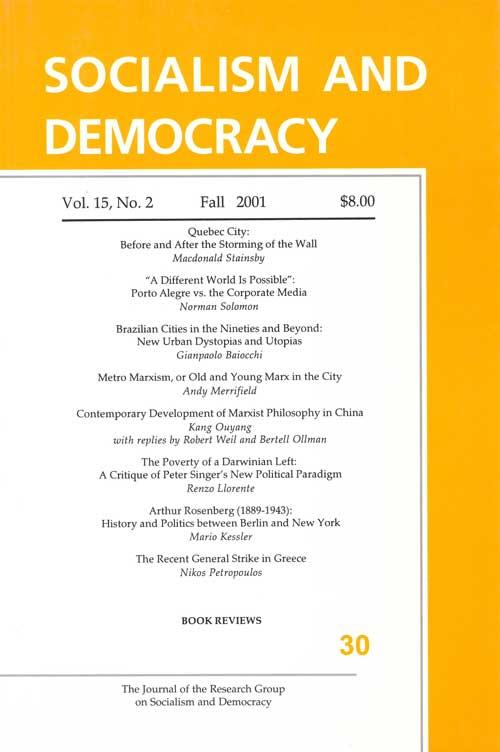August H. Nimtz, Jr. Marx and Engels: Their Contributions to the Democratic Breakthrough. Albany, N.Y.: State University of New York Press, 2000.
“Standing up in front of real, live people and holding forth to them directly and straightforwardly, so that they see and hear you, is something quite different from engaging in this devilishly abstract quill-pushing with an abstract audience in one’s mind’s eye.”
-- Engels to Marx
What impact did Marx and Engels have on the 1848 bourgeois revolutions in Europe? Was Marx merely a radical philosopher involved only in fringe politics? Were Marx and Engels only theoreticians with utopian illusions? Was Engels nothing but Marx’s intellectual sidekick, or was he at crucial times the leading intellectual force in their relationship? Were Marx and Engels two armchair revolutionaries who sought only to be the elitist leaders of a proletarian movement? Or did they actively participate in organizing and rallying the proletariat?
August H. Nimtz, Jr., Professor of Political Science at the University of Minnesota, successfully addresses these questions and puts to rest the myth that Marx and Engels were only armchair revolutionaries. He shows, on the contrary, that they were deeply involved in working-class organizing, and that although they were committed to revolution, they recognized that this could not be brought about by indulging in fringe or conspiratorial types of political activity. Marx and Engels were thus democrats in the true sense; they sought to build a movement rather than to act “on behalf of” the people. The organizations they founded, such as the Communist League and of the Communist Correspondence Committees, were not given over to intrigues but rather sought to develop the consciousness of the working class. Nimtz chronicles in great detail the contributions of Marx and Engels to the bourgeois revolutions of 1848, emphasizing their view that a "scientific perspective" is necessary for a successful proletarian revolution. He recounts in full the circumstances of their exile from Prussia for their activity in editing and publishing the Neue Rheinische Zeitung (NRZ). Major consideration is also given to the impact of the Communist Manifesto. Here again, Nimtz calls our attention to the priority that Marx and Engels gave to long-term struggle, over immediate political tactics.
Nimtz asks us to consider how important and influential the Marx-Engels team was for all workers’ movements in nineteenth-century Europe. For decades following the failures of the 1848 revolutions, Marx and Engels worked to organize a true workers’ movement free of what Marx called “bourgeois hypocrisies.” At the same time Marx developed the foundations for his magnum opus, Capital. Throughout this period, Marx and Engels remained politically active. Some fifteen years after the demise of the Communist League in 1850, they were asked to join the International Working Men’s Association (IWMA) and to write its rules, which Marx was glad to do.
The importance of this historically informed and politically sophisticated book is not merely the chronicling of Marx’s and Engels’ political activity. Nimtz effectively refutes some commonly held views about Marx and Engels. The first is that they were elitists concerned only with creating a dictatorship. In fact, when Marx and Engels were asked to write the rules of the IWMA, they insisted that only workers should be permitted to join. Fearing that intellectuals would infuse the workers’ party with bourgeois prejudices, Marx underlined the importance of excluding them. The second misconception, linked to his phrase “the idiocy of rural life,” is that Marx scorned the peasantry. Contrary to this view, Marx expressed the fervent hope, at the time of Poland’s 1863 peasant revolts, that the unrest would spread to Russia, sparking an eventual proletarian revolution. Marx and Engels also looked to the Polish peasantry to reinvigorate the increasingly pessimistic German working class. A third misconception is that Marx and Engels did not support trade unions, claiming that they were only reforming and not revolutionizing the proletariat. But Marx, in his proposals to the IWMA and particularly in his work Trade Unions, Their Past, Present and Future, highlighted the capacity of trade unions to mobilize labor for its struggle against organized capital. In a similar vein, Marx and Engels took up a number of other demands that fell far short of being direct calls for revolution. During the Paris Commune of 1871, they were among the first to advocate Women’s Rights and the abolition of Child Labor under capital. Marx urged the creation of a non-discriminatory trade union, or the inclusion of women in existing unions. The IWMA (subsequently known as the First International) was itself an organization that gave due recognition to the importance of workers’ short-term demands.
For all those interested in the history of Marxism in nineteenth-century Europe, this book is a must read. But beyond the history, Nimtz provides a full account of the link that existed for Marx and Engels, throughout their careers, between theory and practice. He shows how this link was expressed not just in their historical or theoretical understanding, but also in the active stance they took at each point in the development of the class struggle.
Euripides Pelekanos
Baruch College, CUNY

